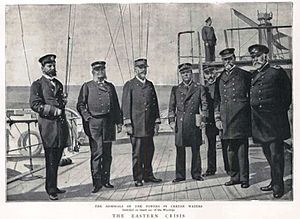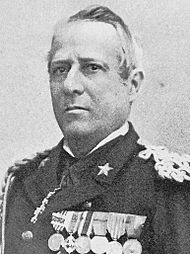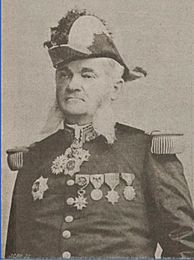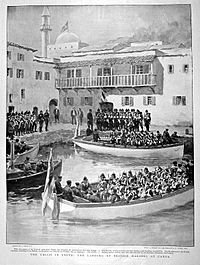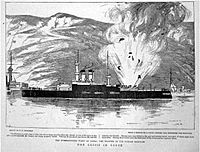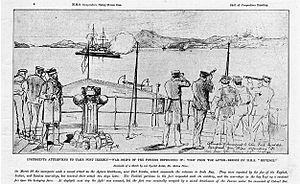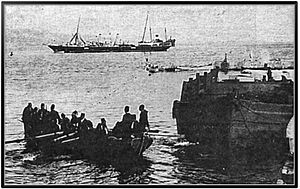International Squadron (Cretan intervention, 1897–1898) facts for kids
Quick facts for kids International Squadron |
|
|---|---|
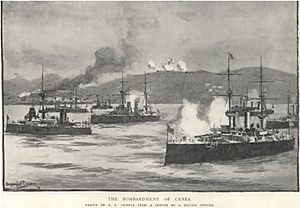
|
|
| Active | February 1897 – December 1898 |
| Country | Multinational |
| Type | Naval squadron |
| Engagements |
|
The International Squadron was a group of warships from several powerful countries. It was formed in early 1897 to help stop a rebellion on the island of Crete. At that time, Crete was ruled by the Ottoman Empire, but many Greeks on the island wanted to join Greece.
Warships from Austria-Hungary, France, the German Empire, Italy, the Russian Empire, and the United Kingdom made up this squadron. They operated around Crete from February 1897 to December 1898.
The most senior admiral from each country's ships in Crete formed a special group called the "Admirals Council." This council was in charge of managing affairs on Crete until December 1898. The top admiral in the area also led the International Squadron and the council. First, Italian Vice Admiral Felice Napoleone Canevaro led the squadron. Later, French Rear Admiral Édouard Pottier took over in mid-1898.
During its time, the squadron fired on parts of Crete, sent sailors and marines ashore, and created a blockade around Crete and some Greek ports. They also supported international forces on the island. After Austria-Hungary and Germany left, the other four countries continued the mission. The squadron helped end the fighting on Crete. Its admirals decided that Crete should become a new, self-governing state under the Ottoman Empire. In late 1898, the squadron removed all Ottoman forces from the island. They also brought Prince George of Greece and Denmark to Crete to lead the new Cretan State. This ended direct Ottoman rule on the island.
| Top - 0-9 A B C D E F G H I J K L M N O P Q R S T U V W X Y Z |
Why the Squadron Was Formed
In 1896, several powerful countries, known as the Great Powers, convinced the Ottoman Empire to make changes in how it ruled Crete. The Ottomans had controlled Crete since 1669. The changes were meant to protect the island's Christian people. Many people in Greece felt strong sympathy for these Christians.
However, the Ottomans did not make the promised changes. On January 23–24, 1897, Christians in Canea (Chania) were attacked. This led to a revolt on January 25, 1897. The Cretan Christians wanted Crete to become part of Greece. Greek Army troops and Greek Navy ships helped the rebels. The rebels took control of much of the countryside. Ottoman troops mostly held onto the large towns and a few isolated spots.
The Great Powers wanted the Ottomans to keep their promises. They also wanted to prevent a war between Greece and the Ottoman Empire. They feared such a war would lead to Greece's defeat and might spread across Europe. So, six Great Powers—Austria-Hungary, France, the German Empire, the Kingdom of Italy, the Russian Empire, and the United Kingdom—decided to step in. They pressured the Ottomans not to send more soldiers to Crete. In return, they promised to keep the Ottoman soldiers already on the island safe.
How the Squadron Started
Even before 1897, some warships were in Cretan waters. For example, in May 1896, the British battleship HMS Hood and a French gunboat arrived. They were there to protect their countries' people and interests. When big riots happened in Candia (now Heraklion) on February 6, 1897, sailors from the British battleship HMS Barfleur stepped in. They helped calm things down and protect British citizens.
As the situation on Crete worsened in early 1897, more ships arrived. Warships from Austria-Hungary, France, Italy, Russia, and Britain came in February 1897. This was to show that the Great Powers wanted the fighting to stop. They also wanted to protect Christians on the island without separating Crete from the Ottoman Empire.
The first British warships to join Barfleur arrived on February 9, 1897. These included the battleships HMS Revenge and HMS Rodney. By February 13, ships from Austria-Hungary, France, Italy, and Russia were anchored off Crete. Germany also promised to send ships. These ships gathered in the harbor at Canea (now Chania). They soon formed the International Squadron. The admirals leading each country's ships began working together to handle the situation on the island.
What the Squadron Did
Early Actions
Greek Involvement
While the six powers discussed what their navies should do, Greece decided to help the Cretan Christian rebels. The Greek Navy ironclad Hydra arrived off Crete in early February 1897. It was supposedly there to protect Greek interests. On February 12, a Greek Navy squadron arrived at Canea. This squadron included the steam sloop-of-war Sphacteria and four torpedo boats. It was led by Prince George of Greece and Denmark. His orders were to support the Cretan rebels and attack Ottoman ships.
The admirals of the International Squadron told Prince George they would use force if Greece acted aggressively around Crete. Prince George's squadron left Cretan waters on February 13 and went back to Greece. That same day, the admirals heard that Greek warships had fired on an Ottoman steamship. They told the Greek Navy commander that Greek ships could not fire at Ottoman vessels in Cretan waters.
However, the situation got worse on February 14. A Greek Army force, led by Colonel Timoleon Vassos, landed at Platanias, west of Canea. This force had about 1,500 soldiers and two artillery units. Vassos announced that his troops were there to take over Crete for the King of Greece. He also declared that Greece was taking control of Crete. Because of this, the Ottoman governor of Crete, George Berovich, fled to Trieste on February 14. He left on the Russian battleship Imperator Nikolai I.
Vassos's declaration challenged both the Ottoman Empire and the Great Powers. With Berovich gone, Crete had no government. To deal with this, the International Squadron took its first direct action on February 15, 1897. They landed 450 sailors and marines from their ships in Canea harbor. These included 100 men each from France, Italy, Russia, and the United Kingdom, and 50 from Austria-Hungary. They raised the flags of all six Great Powers over Canea. This marked the start of the international occupation of Crete. It also began the role of the International Squadron's admirals in managing the island through the Admirals Council.
When the first German warship, SMS Kaiserin Augusta, arrived on February 21, she added 50 more men to the occupying force. The International Squadron decided that the most senior admiral present would lead the squadron. Italian Vice Admiral Felice Napoleone Canevaro became the commander on February 16 or 17. He also became the head of the Admirals Council. The squadron ordered Vassos to stay at least 6 kilometers (3.75 miles) from Canea. But he began trying to capture the town. This led to a fight on February 19, 1897, where his forces defeated a 4,000-man Ottoman force in the Battle of Livadeia. The International Squadron demanded that Vassos stop his attacks on Canea. They also captured several supply ships sent to him.
February Bombardments
While Vassos's troops moved on Canea from the west, Cretan rebels with Greek Army artillery moved from the east. They took control of high ground east of Canea. This rebel force included Eleftherios Venizelos, who later became a prime minister of Greece. They threatened to shell Canea and attacked the town on February 13 and 14. Ottoman troops and Muslim irregulars fought them off.
On February 21, 1897, the rebels raised a Greek flag over their position. The International Squadron ordered them to take the flag down and leave. When they refused, Vice Admiral Canevaro ordered the squadron to fire on their positions. This was the squadron's first direct use of force.
Some ships could not fire because other ships were in the way. But the British battleship HMS Revenge, and torpedo gunboats HMS Dryad and HMS Harrier fired. The Russian battleship Imperator Aleksandr II, the Austro-Hungarian armored cruiser SMS Kaiserin und Königin Maria Theresia, and the German protected cruiser Kaiserin Augusta also fired. HMS Revenge fired three 6-inch (152-mm) shells into the rebel base. The shelling, which rebels said was up to 100 rounds, made them take the Greek flag down. The warships stopped firing after five to ten minutes. The rebels left without shelling Canea. They had three killed and several wounded.
A rebel named Spiros Kayales became a Cretan hero. He grabbed the Greek flag after the squadron's shells knocked it down twice and held it up himself. A legend says that Kayales's bravery impressed the sailors so much that they cheered. It's said that Canevaro, seeing Kayales, ordered the ships to stop firing. And that the Admirals Council decided Crete should be self-governing because of Kayales's actions. In reality, the ships were too far away to hear cheers. The council's decision for Crete's autonomy was based on politics and negotiations, not one person's bravery. Still, Cretans celebrate Kayales's heroism every year on February 9.
The bombardment was a military success. But it made Cretan rebels even more determined. It also made Muslims on the island think the squadron was helping them, not just trying to stop fighting.
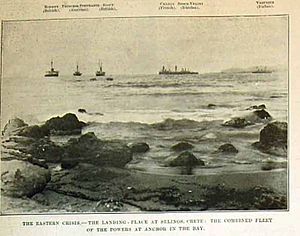
By February 26, the International Squadron had most of its ships in Suda Bay, east of Canea. From there, they could fire on rebels on the Akrotiri Peninsula. The squadron's men ashore also started patrols to keep the road between Canea and Suda open. On February 28, 1897, rebels attacked the Ottoman blockhouse at Aptera. This blockhouse overlooked Suda Bay and supported the Izzeddin Fortress. After getting permission, the Ottoman Navy ironclad Mukaddeme-i Hayir fired three accurate shots. Its gunfire cleared the rebels from the hills around the blockhouse.
Kandanos Expedition
There were reports of Christians attacking Muslims on Crete. So, there was growing concern for the safety of Ottoman soldiers and Muslim people in Kandanos. Ships from the International Squadron, including the British battleship HMS Rodney , arrived off Selino Kastelli (now Palaiochora) on March 5, 1897.
On March 6, an international landing force went ashore. It included 200 British Royal Marines and sailors, 100 men each from Austria-Hungary and France, 75 Russians, and 50 Italian sailors. They were led by Captain John Harvey Rainier of Rodney. They began an expedition to Kandanos, arriving on March 7. The expedition left Kandanos on March 8, bringing 1,570 civilians and 340 Ottoman soldiers with them. They also picked up 112 more Ottoman troops from a fort at Spaniakos.
Stopping for the night at Selino Kasteli, the expedition was fired upon by Christian rebels. These rebels were attacking two small Ottoman forts outside the village. But a Russian field gun drove them off. The expedition helped one of the forts overnight. On the morning of March 9, Christian rebels fired again. But the expedition's artillery and gunfire from the warships in the bay silenced them. The expedition then charged with bayonets, helping the second Ottoman fort. The expeditionary force, along with the rescued Ottoman soldiers and Muslim civilians, left by sea. No European personnel or rescued Ottoman soldiers were hurt. Only one Muslim civilian was wounded during the four-day mission. The Christian rebels lost four killed and 16 wounded.
Sissoi Veliky Explosion
A sad event happened on March 15, 1897. The Russian battleship Sissoi Veliky had an explosion in its rear 12-inch (305-mm) gun turret. This happened during a target practice session off Crete. The explosion blew the turret roof over the mainmast. It hit the base of the foremast and crushed a steam cutter and a 37-millimeter gun. The explosion happened because a safety device was turned off. This allowed a gun to fire before it was properly closed. Sixteen men died instantly, and 15 were injured. Six of the injured later died. Sissoi Veliky went to Toulon, France, for repairs.
Blockade and Occupation
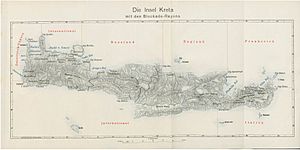
On March 17, 1897, the Austro-Hungarian torpedo cruiser SMS Sebenico was patrolling. It was trying to stop Greek supplies from reaching Crete. It stopped a Greek schooner carrying weapons and Cretan rebels off Cape Dia, Crete. After an exchange of gunfire, Sebenico sank the schooner. The schooner's crew were not hurt and swam to shore.
The Great Powers told the Admirals Council to make a plan. This plan would force Greece to remove its troops from Crete. The admirals' plan, announced on March 18, 1897, had two parts. First, they would create a blockade around Crete and the main ports in Greece. No Greek ships could enter Cretan ports. Ships from other countries could only unload cargo at Cretan ports held by the International Squadron. This blockade started on March 21, 1897.
Each country took responsibility for blockading different parts of Crete. The second part of the plan was to divide Crete into five occupation zones. Each of the six powers would send army troops to the island. These troops would take over occupation duties from the sailors and marines. Germany, which was becoming more supportive of the Ottoman Empire, refused to send troops. It only contributed one ship and the marines it sent ashore. However, troops from the Austro-Hungarian Army, British Army, French Army, Italian Army, and Imperial Russian Army began landing in Crete in late March and early April 1897. By early April, about 2,500 troops were ashore. These troops were under the Admirals Council. The council told British Army Major General Herbert Chermside, the overall commander of the occupation forces, not to place his troops beyond the range of the International Squadron's guns.
March Bombardments
As European soldiers arrived, the rebels attacked the Aptera blockhouse again. They captured it on March 25, 1897, despite shelling from Ottoman warships. After the rebels took the blockhouse, smaller warships of the International Squadron fired about a hundred shells. One heavy shell from the Italian protected cruiser Giovanni Bausan went through the blockhouse walls and exploded inside. This drove the rebels out. Some shells also damaged the villages of Malaxa and Kontopoulo.
On March 26 and 27, the British battleship HMS Camperdown fired its guns for the first time in its history. It fired from 5,000 yards (4,572 meters) at rebels attacking the Izzeddin Fortress. This included four 1,250-pound (567-kg) rounds from its huge 13.5-inch (343-mm) guns. This forced the rebels to stop their siege. Then, Royal Marines from the British battleship Revenge landed and took control of the fort.
Other Actions
While soldiers took over occupation duties, the squadron continued to deal with threats from rebels. It also began supporting the troops ashore. In March, French marines landed on Crete. They helped Ottoman troops defend Fort Soubashi, southwest of Canea, against Greek Army and Christian rebel forces. On March 30, French marines joined an international group to protect a fresh water source at the fort.
In late March, the British battleship HMS Rodney shelled rebels trying to dig under the walls of the Ottoman fort at Kastelli-Kissamos. This drove them away. The International Squadron landed 200 Royal Marines and 130 Austro-Hungarian sailors and marines. They resupplied the fort and tore down nearby buildings that had helped the rebels. Elsewhere, the Italian battleship Ruggiero di Lauria stopped a threat from Cretan rebels at Heraptera (now Ierapetra) by threatening to bombard them.
After these actions in late March 1897, the International Squadron and European troops expected a big rebel attack. But no major attack came. In fact, after the bombardments, organized rebel attacks against Ottoman and European forces ended. Fighting was then limited to occasional sniping. The International Squadron's admirals held a review of the international occupation force in Canea on April 15, 1897. This was likely to show the locals the military power the Great Powers had to enforce peace. However, as late as April 21, 1897, the British battleship HMS Camperdown anchored off Canea. It was there to deter rebels who were threatening the town with artillery.
Greco-Turkish War of 1897
The Greco-Turkish War (1897), also called the Thirty Days War, began on the European mainland. Greek forces crossed into Ottoman Macedonia on March 24, 1897. A formal declaration of war followed on April 20. As the Great Powers expected, the war ended quickly with a big Greek defeat. A ceasefire began on May 20, 1897.
Vassos, the Greek commander on Crete, had achieved little. The International Squadron's actions and the blockade stopped him from advancing or getting supplies. He left Crete on May 9, 1897. The ceasefire agreement required all Greek forces to leave Crete. So, his expeditionary force boarded the British protected cruiser HMS Hawke on May 23, 1897, and left the island. On September 20, 1897, Greece and the Ottoman Empire signed the Treaty of Constantinople, officially ending their war.
Working Towards Peace
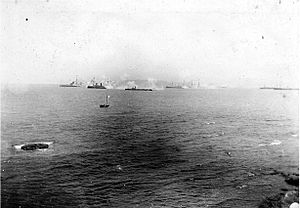
Even after the war on the mainland, the Christian rebellion on Crete continued. However, the military threat to the European Powers decreased a lot after March 1897. The International Squadron and the occupying forces could then focus on ceremonies. For example, they had a parade for Italy's role on May 4, 1897. They also celebrated Queen Victoria′s Diamond Jubilee on June 22, 1897.
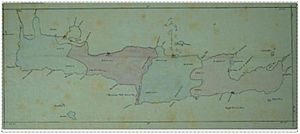
With the island quiet, the Admirals Council tried to make a deal between the rebels and Ottoman forces. They wanted to end the revolt without the Ottomans leaving Crete. But this was not possible. The Admirals Council then decided to create a new, self-governing Cretan State. This state would manage its own affairs but still be under the Ottoman Empire.
Germany, which was increasingly on the Ottoman Empire's side, strongly disagreed. It left Crete and the International Squadron in November 1897. Austria-Hungary also left in March 1898. Even though German and Austro-Hungarian ships and troops left, the four remaining Great Powers continued the blockade and occupation. They divided Crete into zones of responsibility. Italy took the western part of the island. Russia took the west-central part. The United Kingdom took the east-central part. France took the eastern area. Canea and Suda Bay remained under joint control.
After deciding to create the Cretan State, the Admirals Council looked for someone to lead it. They offered the job to Vice Admiral Canevaro, but he said no. He left the International Squadron on June 1, 1898, to become Italy's Minister of the Navy. French Rear Admiral Édouard Pottier took over as squadron commander and council president. The search for a leader continued.
By spring 1898, the Powers began to ease the blockade. They also reduced their ships and troops on Crete. For example, the British presence dropped to one army battalion ashore. Usually, there was one battleship, one cruiser, and one gunboat at sea. With Crete quiet, the British commander, Rear-Admiral Gerard Noel, left Crete. He let the senior British naval officer at Crete attend Admirals Council meetings. The council also started to give more freedom to lower-ranking officers in dealing with island affairs. On July 25, 1898, the Admirals Council made a big move. They handed over civil administration of Crete, except for the occupied towns, to the Christian Assembly. This assembly was meant to become the law-making body of the Cretan State.
Candia Riot
Cretan rebels did not pay taxes during the revolt. Only Muslim people in Cretan towns paid taxes. This made it hard to fund the island's government. Finally, the Admirals Council decided to put the customs houses on Crete under British control. The British would collect an export duty to fund the island's welfare. They ordered the Ottomans to give up the customs houses. They also planned to replace Muslim officials with Cretan Christians. The takeover of customs houses in Canea and Rethymno on September 3, 1898, went smoothly.
However, when the British tried to take control of the customs house at Candia (now Heraklion) on September 6, violent resistance broke out. Muslim residents believed they were being forced to pay for Christians to take over their rights. Only 130 British soldiers were ashore, and the Royal Navy torpedo gunboat HMS Hazard was the only warship there. Muslim mobs attacked British officials, soldiers, and sailors at the harbor and customs house. They also began killing Christian residents. They fired heavily on British military personnel at the harbor and later at the British camp and hospital.
Hazard sent more troops ashore and began firing on the town. The pressure on British forces at the harbor gate was so strong that they retreated to the water ship SS Turquoise in the harbor. The Muslims around the customs house and harbor did not stop firing until Ottoman troops arrived. The local Ottoman governor, Edhem Pasha, finally appeared late in the afternoon to restore order. When British forces at the camp and hospital fell back to the Ottoman fort, Ottoman troops also stepped in there to stop the disturbance. The riot ended in the early evening. Ottoman forces did not otherwise help the British, protect Christians, or keep order. Estimates of deaths vary. The British lost 14 to 17 military personnel and at least three civilians. Between 27 and 39 servicemen were wounded. Muslims killed between 153 and nearly a thousand Christians, according to different reports.
After a tense night, more ships arrived. The British battleship HMS Camperdown arrived on September 7 and sent Royal Marines ashore. French, Italian, and Russian warships also arrived. Austria-Hungary, though no longer part of the squadron, sent the torpedo cruiser SMS Leopard. The International Squadron sent 300 French marines and Italian mountain troops from Canea to Candia. British Army forces also began to arrive. By September 23, 2,868 British troops were there.
The International Squadron's senior British commander, Rear-Admiral Gerard Noel, arrived at Candia on his flagship HMS Revenge on September 12, 1898. He immediately went ashore to see the riot scene. He ordered the Ottoman governor, Edhem Pasha, to meet him on Revenge the next morning. At the meeting, Noel ordered Edhem Pasha to tear down buildings used by rioters. He also demanded that all Muslims in the city be disarmed. He insisted that all customs duties owed since May 3, 1898, be paid daily. Finally, he demanded that those responsible for starting the riot be handed over for trial. When Edhem Pasha refused, Camperdown and Revenge fired a warning shot, which changed his mind. Ottoman officials met all of Noel's demands.
The British took custody of the first accused murderers on September 14. They quickly tried those accused of killing British military personnel in military courts. Those accused of killing British civilians were tried by a British military tribunal. Twelve men were found guilty of murdering British soldiers, and five of murdering British civilians. All 17 were sentenced to death by hanging. They were held on the British protected cruiser HMS Isis before their trials and executions. The men were publicly hanged in important locations. The first seven were hanged on October 18, and the last five on October 29. The five men who killed British civilians were hanged on November 5. Two men convicted under Italian law for killing Cretan civilians were executed by a firing squad on November 23. After this, the death penalty for killing Christian civilians was stopped.
Ottoman Forces Leave Crete
The Candia riot changed how the International Squadron viewed the situation. Before, they saw Christian rebels as hostile and protected Ottoman forces. But the Ottomans' unhelpful behavior during the riot changed this. After the riot, the squadron saw the Ottomans as the hostile force. The Admirals Council decided that all Christian and Muslim residents must be disarmed. They also decided that all Ottoman forces must leave Crete.
The Ottomans delayed. The Great Powers' patience ran out on October 4, 1898. They demanded that all Ottoman forces leave Crete by October 19. The Ottomans agreed to leave in principle. But they objected to the deadline and wanted a small force to stay to guard the Ottoman flag. They kept delaying. Finally, they began to withdraw their forces on October 23. However, they stopped the withdrawal on October 28. About 8,000 Ottoman troops were still on the island. This was to avoid embarrassing the Ottoman Empire during a visit by Germany's Kaiser Wilhelm II to Constantinople.
At Britain's insistence, the Admirals Council demanded that the Ottoman flag be taken down in Canea. This happened on November 3. They also demanded that all Ottoman troops leave the island by November 5. If not, the Powers threatened to sink all Ottoman ships in Suda Bay. They also threatened to bombard and destroy the Izzeddin Fortress. Then, they would bombard Canea, Hieraptra, Spinalonga, Kissamos, and Rethymo. The Ottoman government would have to pay for any damages. The International Squadron and the occupying forces made plans to carry out these threats.
The Ottomans responded by restarting the evacuation. But after the November 5 deadline, about 500 Ottoman troops remained in Candia. The British took control of Candia on November 5. On November 6, 1898, British troops removed the remaining Ottoman troops from their barracks. Officers and men from the British battleships HMS Revenge and HMS Empress of India supervised. The last Ottoman forces in Crete boarded the British torpedo gunboat HMS Hussar. They were taken to Salonica. Their departure ended 229 years of Ottoman rule on Crete. However, a few Ottoman troops stayed until December 1898 to oversee the removal of Ottoman weapons. Arguments continued into December over how many Ottoman troops could stay and what ranks they could hold.
On November 6, 1898, with the last Ottoman troops gone, the Admirals Council ordered the Ottoman flag to be raised again. This was to show Muslim Cretans that their rights would still be respected, even without direct Ottoman rule.
Bringing Prince George to Crete
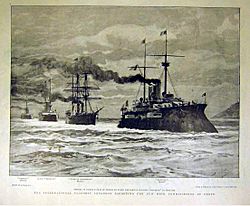
On November 26, 1898, the Admirals Council officially offered the leadership of the Cretan State to Prince George of Greece and Denmark. Prince George accepted. With the last Ottoman forces gone, the squadron's final job was to arrange Prince George's arrival. This would mark the start of the new state.
There were some issues with his transportation. He first suggested arriving on the Greek royal yacht, but the Admirals Council said no. Greece then suggested a Greek Navy warship, but the admirals also rejected this. Greece then proposed a Greek merchant ship flying the Greek flag. The four powers all rejected this idea too. Finally, the Admirals Council told Prince George that the International Squadron would bring him. A European warship flying its own national flag would carry him, escorted by warships of the other three powers.
Prince George's arrival was delayed at the last minute. An argument broke out among the four powers over the design of the new Cretan State's flag. Once the new flag's design was approved by all four powers, the four flagships of the International Squadron finally sailed on December 19, 1898, to Milos. Prince George was waiting there on his yacht.
He boarded the French protected cruiser Bugeaud on December 20. This ship carried the squadron's senior commander, Vice Admiral Édouard Pottier. Escorted by the other three flagships—the Italian battleship Francesco Morosini, the Russian armored cruiser Gerzog Edinburgski, and the British battleship HMS Revenge—Bugeaud took him to Suda. He disembarked on December 21, 1898, to begin his duties as High Commissioner of the new Cretan State. His arrival ended 229 years of direct Ottoman rule on Crete. It also ended the Admirals Council's control of the island.
On December 26, 1898, the Admirals Council was officially dissolved. Its work was done, and the International Squadron broke up.
What Happened Next
The Cretan State, created by the admirals' decisions, existed until 1913. Foreign troops stayed on the island until 1909. Royal Navy ships remained there until 1913. In 1913, after Greece won the Second Balkan War, Greece officially took control of Crete in the Treaty of Athens.
See also
- Cretan State
- Cretan Turks
- History of Crete
- Ottoman Crete


